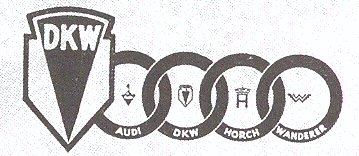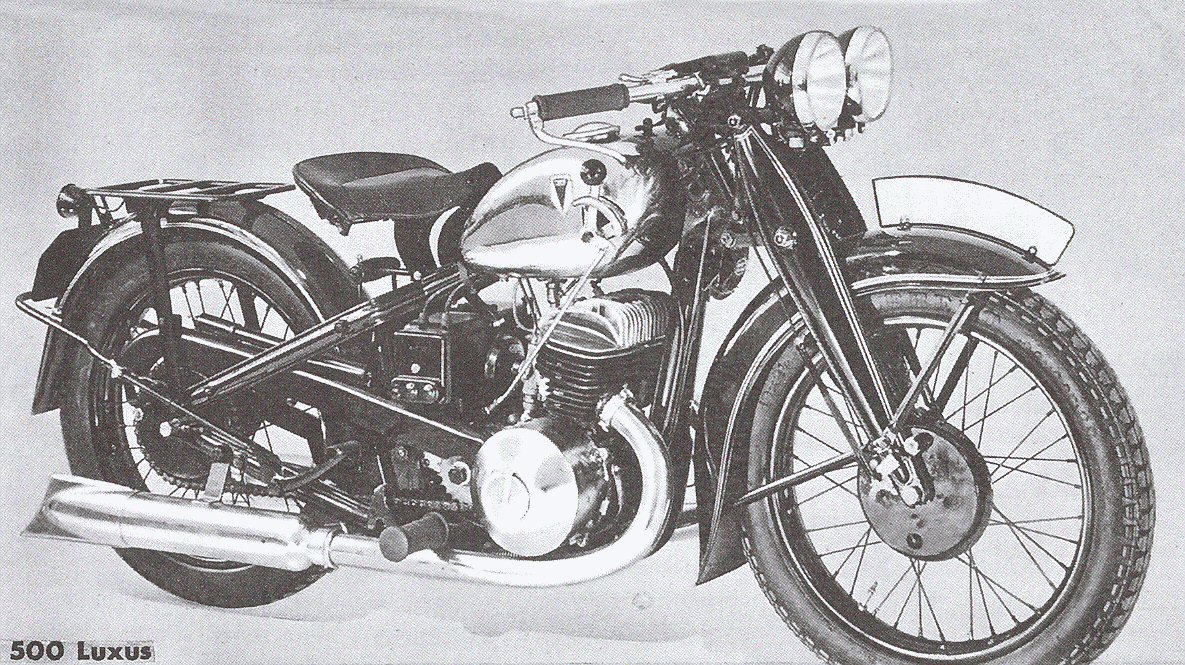
In 1907 a Dane
engineer, Jörge Skofte Rasmunssen, settles down in old company of
thread in Zschopau (Germany), and creates a steam motor called "Dampf
Kraff Wagen" ("Steam Automovil"). Later, with another engineer,
Hugo Ruppe, in 1919, at the end of the WWI, they leave the steam
and began with the explosion engines with a small one, 2
strokes
and 18 cc. that was used for little toys, with
abbreviations DKW called "Des Knaben Wunsch" ("the child desire"). They
perfectioned this
motor, and builded another 2 strokes engine of 118 cc., that was
put into the rear bicycle wheels. It was presented in the 1919 fair,
with remarkable improvements respect to its competitors (automatic
clucth), an began the DKW launch. Germans called it lovely "Das
Kleine Wunder" (The little wonder).
Already in 1921 DKW had sold more than 20,000 units of this engine. This engine also was used for sport competitions.
Already in 1921 DKW had sold more than 20,000 units of this engine. This engine also was used for sport competitions.

In 1921 they began to build more equiped motorcycles, this is the one called "golem", builted from the DKW engine by Ernst Eichler.
The first DKW motorcycle is created in 1922 spring, it is a 2 stroke and 148 cc with 1.5 PS, this model had the engine inside the frame, and was called "Imperial Trip" after won a price race. DKW builds 30.000 engines of this kind, and in the next 4 years, reached 20.000 units of this model.
There were the sport model and the race model of this motorcycle.
In 1924 was built the new "ZM", with a new engine, 170 cc and 3 PS. There was a "ZM" sport model with a gearbox of 2 speeds and kickstart.
The same year 1924 DKW build two new engines, 128 and 206 cc.
In 1925 the 206 engine is evolutioned to "E206" with 4 PS, and the new SM motorcycle.
But in 1926 with a new engineand a new frame the anual production arrives to 20.000 units, making 100 engines per day, in the second half of the year.
In the end of 1926 appears the Z-500 model , destinated to the medium class people because of its high price, but with some engine heat problems, they will have to make a water cooled engine.
In 1927 born the E250, a new 6 PS sport model.
In April of 1928 DKW had maked 49.000 units of the E206 model, but a new tax of motorcycles force DKW to change its E206 model to the E200 model (reducing the bore from 64 to 59 mm), to jump the tax. At the same time they change the E250 to the E300 model, growing its power.
The E200, E300 and Z-500 (with the water cooled engine) were in sale until the end of 1929.
It is in the same year, 1929, when DKW developes its new fork, with pressed steel, and the new fuel tank, whom called "Luxus" to the new models bringing it.

It is the record year, 1929, 60.000 units maked, and DKW becomes the biggest motorcycle factory in the world. Also it is the Crack year, and sell began to decrease.
The Luxus E300 borns in 1930, with a new 9 PS engine, foot shifter and double muffler. The superior model is the Sport 600, and also goes out the popular bicycle ES-200, without kickstar or gearbox. The KM-175 production begans, stopping the 200 model.
It is in 1931 when the E300, is changed by a 200 cc version with 6 PS and double muffler, also a transition model, the TM-200 with gearbox out of the engine. The Block 200 and 300 are also going out to street.
1932, is the union of AUDI, DKW, HÖRCH and WANDERER, becoming the new AUTO UNION A.G.
This year there is a very important new in DKW engines, thanks to the new system of Adolf Schnürle, that DKW buys. It is a new admission system, with a flat piston, that reduces the fuel consuption and improve the engine cooling. With this new system DKW makes a new 350 cc engine, wit 11 PS.

This new
name and DKW become the new logotypes from now.
In 1933 goes out to street the Sport 350, and the 175, 200 engine cases without kickstart, uses the new admission system too. This admission system was also used in 500 engines, then they become to be air cooled only. This year there was another change , a fourth speed in 500 cc motorcycles, but it will keep only one year, when the new SB-500 model is created, with a better fork. This year the Blocks had an electric starter.
In 1934 DKW develops two new engine models, 98 and 100 cc., also the RT-100, a little motorcycle with 3 speed transmission and kickstarter.
Taking the 175 model, the new KM-200 was born as an economic model, with a "Luxus" version.
Next model was the SB-200, inspired in the Block 200, and the "luxus" version with electric starter. The SB-300 and SB-500, with battery in the "luxus" model.

In November of 1935 the 300.000 DKW is maked, and three years later, in February of 1939 the 500.000.
At the end of 1937 (due to a new drive license) the SB-250 is made instead of the SB-200, and the new NZ-350 that is a complete remodelation.
One year later the SB-200 and SB-250 are stopped, only the cheap KS-200 keep on the line, and in July of 1939 when the NZ serie is completed with a twin cylinder, with 18,5 PS. , four speeds. The fork comes with an oil shock, and in the back, with adjustable springs.
The NZ-500 was a short made model, because of the war, began in September of 1939, 1500 NZ-500 come to Spain. In summer of 1940 the production was stopped.
I want to thank to Javier and Emilia for their help in the German traduction.
Eduardo.
In 1933 goes out to street the Sport 350, and the 175, 200 engine cases without kickstart, uses the new admission system too. This admission system was also used in 500 engines, then they become to be air cooled only. This year there was another change , a fourth speed in 500 cc motorcycles, but it will keep only one year, when the new SB-500 model is created, with a better fork. This year the Blocks had an electric starter.
In 1934 DKW develops two new engine models, 98 and 100 cc., also the RT-100, a little motorcycle with 3 speed transmission and kickstarter.
Taking the 175 model, the new KM-200 was born as an economic model, with a "Luxus" version.
Next model was the SB-200, inspired in the Block 200, and the "luxus" version with electric starter. The SB-300 and SB-500, with battery in the "luxus" model.

In 1935 the
KM-200 takes the double muffler, the SB-300 goes into the new SB-350 ,
higher muffler and hand&foot shiftting.
The new RT 3 PS, from
the RT-100, with new fork and more power. From 1937 the bikes takes new
tools boxes and fuel tanks.
The KM-200L evolutions to KS-200 with the SB frame, keeping the
cheap motorcycle idea.In November of 1935 the 300.000 DKW is maked, and three years later, in February of 1939 the 500.000.
At the end of 1937 (due to a new drive license) the SB-250 is made instead of the SB-200, and the new NZ-350 that is a complete remodelation.
One year later the SB-200 and SB-250 are stopped, only the cheap KS-200 keep on the line, and in July of 1939 when the NZ serie is completed with a twin cylinder, with 18,5 PS. , four speeds. The fork comes with an oil shock, and in the back, with adjustable springs.
The NZ-500 was a short made model, because of the war, began in September of 1939, 1500 NZ-500 come to Spain. In summer of 1940 the production was stopped.
I want to thank to Javier and Emilia for their help in the German traduction.
Eduardo.